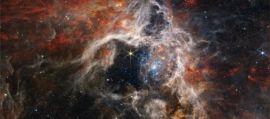“IL MESSAGGERO STELLATO”... il telescopio spaziale Webb
Come Galileo e il suo telescopio hanno fatto per l'umanità nel 17° secolo, il Webb Space Telescope è il nostro ultimo "Messaggero stellato" che ci offre viste impareggiabili dell'Universo
| Richard Brewer |

Immagine: “IL MESSAGGERO STELLATO”... Il James Webb Space Telescope è il principale osservatorio mondiale di scienze spaziali.
OREGON, USA — Quindi qual è il problema e perché dovresti essere interessato alle immagini del telescopio spaziale Webb?
Il 13 marzo 1610 — Galileo pubblicò un opuscolo intitolato "Messaggero stellato" per discutere del libro scientifico più drammatico mai pubblicato. Annunciava nuovi e inaspettati fenomeni nei cieli, "inauditi attraverso i secoli", rivelati da un nuovo misterioso strumento . Fu il primo lavoro scientifico pubblicato basato su osservazioni effettuate tramite un telescopio. Disse alla comunità colta che era iniziata una nuova era e che l'universo e il modo in cui era stato studiato non sarebbero mai stati gli stessi. Galileo riferì di aver visto almeno dieci volte più stelle attraverso il telescopio di quelle visibili ad occhio nudo e ha fornito mappe stellari della cintura di Orione e dell'ammasso stellare Pleiadi che mostrano alcune delle stelle appena osservate.
412 anni dopo, il più grande telescopio spaziale dell'umanità fu aperto al mercato e l'alba di una nuova era nell'astronomia iniziò rivelando un universo diverso da qualsiasi cosa avessimo visto prima. Il 12 luglio 2022 il team del James Webb Space Telescope, non diversamente da Galileo, ha rilasciato le sue prime immagini di qualità scientifica dal nuovo telescopio. Lo scopo di Webb è esplorare le origini - dell'universo, delle galassie, delle stelle e della vita - e le prime immagini mantengono quella promessa. In esse ci sono le più antiche galassie mai viste dagli occhi umani, prove dell'acqua su un pianeta a 1.000 anni luce di distanza e dettagli incredibili che mostrano la nascita e la morte delle stelle. Per Webb non c'è un cielo vuoto, ovunque guardi vede galassie lontane, la maggior parte delle quali fino ad ora erano invisibili. Le prime osservazioni di Webb raccontano una storia dell'universo nascosto... è un momento singolare e storico, l'inizio di qualcosa di veramente rivoluzionario e l'universo non sarà mai più lo stesso.
Mercoledì 19 ottobre, la NASA ha rilasciato una delle immagini più recenti catturate dal James Webb Space Telescope, una nuova spettacolare vista degli iconici "Pillars of Creation" a 6.500 anni luce di distanza che mostra nuove stelle che si formano all'interno delle dense torri di gas e polvere a forma di mano che ricorda la rappresentazione di Michelangelo della "Creazione di Adamo".
IMMAGINE 1: Pillars of Creation 3.jpeg credit:NASA, ESA, CSA, STScI; Joseph DePasquale (STScI), Anton M. Koekemoer (STScI), Alyssa Pagan (STScI)

I luminosi punti rossi visti nei pilastri polverosi sono stelle di nuova formazione e le linee ondulate che sembrano flussi di lava sono espulsioni dalle stelle ancora in formazione mentre sparano getti supersonici che si scontrano con le nubi di gas e polvere circostanti. Il bagliore cremisi proviene da molecole di idrogeno energetiche riscaldate dall'interazione con le nascenti emissioni stellari. Quando parti del materiale nei pilastri di gas e polvere ottengono una massa sufficiente, iniziano a collassare per la loro stessa gravità, riscaldandosi lentamente e formando nuove stelle. Si stima che queste giovani stelle abbiano solo poche centinaia di migliaia di anni.
Il telescopio spaziale Hubble della NASA ha reso famosi i Pilastri della Creazione con le sue immagini nel 1995 e nel 2014 in una visione in luce visibile, ma il telescopio spaziale Webb vede attraverso la polvere che oscura le regioni di formazione stellare. Gli spessi pilastri marrone polveroso non sono più opachi e si vedono molte altre stelle rosse che si stanno ancora formando.
IMMAGINE 2: Hubble vs Webb.jpeg

Come Galileo che vede dieci volte più stelle attraverso il suo telescopio di quante ne siano visibili ad occhio nudo, il telescopio spaziale Webb, utilizzando la visione a infrarossi vicini, vede migliaia di stelle precedentemente nascoste. Ciò aiuterà i ricercatori a rinnovare i loro modelli di formazione stellare e a ottenere conteggi molto più precisi delle stelle di nuova formazione, fornendo al contempo un quadro più chiaro di come le stelle si formano ed esplodono dai loro bozzoli polverosi nel corso di milioni di anni.
Mentre Webb continua la sua missione di scoperta e guardiamo cose che non abbiamo mai visto prima, la cosa più importante che impareremo sarà qualcosa che non ci aspettiamo.
Il James Webb Space Telescope è il principale osservatorio mondiale di scienze spaziali. Webb risolverà i misteri del nostro sistema solare, guarderà oltre mondi lontani attorno ad altre stelle e sonderà le misteriose strutture e origini del nostro universo e il nostro posto in esso. Webb è un programma internazionale guidato dalla NASA con i suoi partner, ESA (Agenzia spaziale europea) e CSA (Agenzia spaziale canadese).
**************IN ENGLISH *********
“THE STARRY MESSENGER” … the Webb Space Telescope: Like Galileo and his telescope did for humanity in the 17th century, the Webb Space Telescope is our latest “Starry Messenger” bringing us unparalleled views of the Universe
OREGON, USA — So just what is the big deal and why should you be interested in the Webb Space Telescope images?
On March 13, 1610 — Galileo published a pamphlet he titled "Starry Messenger” to discuss the most dramatic scientific book ever published. It announced new and unexpected phenomena in the heavens, “unheard of through the ages,” revealed by a mysterious new instrument. It was the first published scientific work based on observations made through a telescope. It told the learned community that a new age had begun and the universe and the way it was studied would never be the same. Galileo reported that he saw at least ten times more stars through the telescope than are visible to the naked eye and he provided star charts of the belt of Orion and the star cluster Pleiades showing some of the newly observed stars.
412 years later, humanity’s greatest space telescope was open for business and the dawn of a new era in astronomy began by revealing a universe unlike anything we have seen before. On July 12, 2022 the James Webb Space Telescope team, not unlike Galileo, released their first science-quality images from the new telescope. Webb’s purpose is to explore origins — of the universe, of galaxies, of stars and of life — and the first images make good on that promise. In them are the oldest galaxies ever seen by human eyes, evidence of water on a planet 1,000 light-years away and incredible details showing the birth and death of stars. For Webb there is no blank sky, everywhere it looks it sees distant galaxies, most of which were invisible until now. Webb’s first observations tell a story of the hidden universe … it is a singular and historic moment, the start of something truly revolutionary and the universe will never look the same again.
On Wednesday, 19 October, NASA released one of the most recent images captured by the James Webb Space Telescope, a spectacular new view of the iconic “Pillars of Creation” 6,500 light-years away showing new stars forming within the dense towers of gas and dust in the shape of a hand that is reminiscent of Michelangelo’s depiction of the “Creation of Adam.”
IMAGE: Pillars of Creation credit NASA, ESA, CSA, STScI; Joseph DePasquale (STScI), Anton M. Koekemoer (STScI), Alyssa Pagan (STScI)
The bright red dots seen in the dusty pillars are newly formed stars and the wavy lines that look like flows of lava are ejections from the still forming stars as they shoot out supersonic jets that collide with the surrounding clouds of gas and dust. The crimson glow comes from energetic hydrogen molecules heated by interaction with the nascent stellar emissions. As portions of the material in the pillars of gas and dust obtain sufficient mass they begin to collapse under their own gravity, slowly heating up and forming new stars. These young stars are estimated to be only a few hundred thousand years old.
The NASA Hubble Space telescope made the Pillars of Creation famous with its images in 1995 and 2014 in a view in visible light but The Webb Space telescope sees through the obscuring dust into the star forming regions. The thick dusty brown pillars are no longer opaque and many more red stars that are still forming come into view.
IMAGE: Hubble vs Webb
Like Galileo seeing ten times more stars through his telescope than are visible to the naked eye, the Webb Space Telescope, using near Infra-red vision, sees thousands of previously hidden stars. This will help researchers revamp their models of star formation and obtain far more precise counts of newly formed stars while providing a clearer picture of how stars form and burst out of their dusty cocoons over millions of years.
As Webb continues its mission of discovery and we look at things we’ve never seen before, the most important thing we will learn will be something we’re not expecting.
The James Webb Space Telescope is the world's premier space science observatory. Webb will solve mysteries in our solar system, look beyond to distant worlds around other stars, and probe the mysterious structures and origins of our universe and our place in it. Webb is an international program led by NASA with its partners, ESA (European Space Agency) and CSA (Canadian Space Agency).























